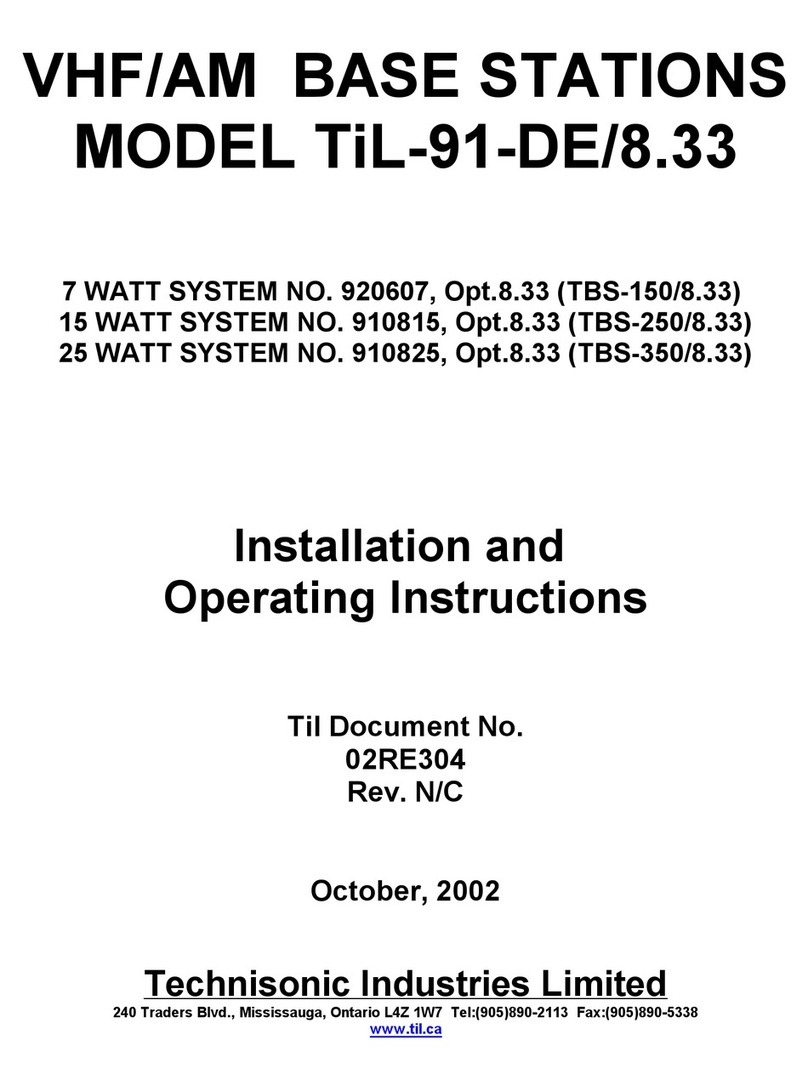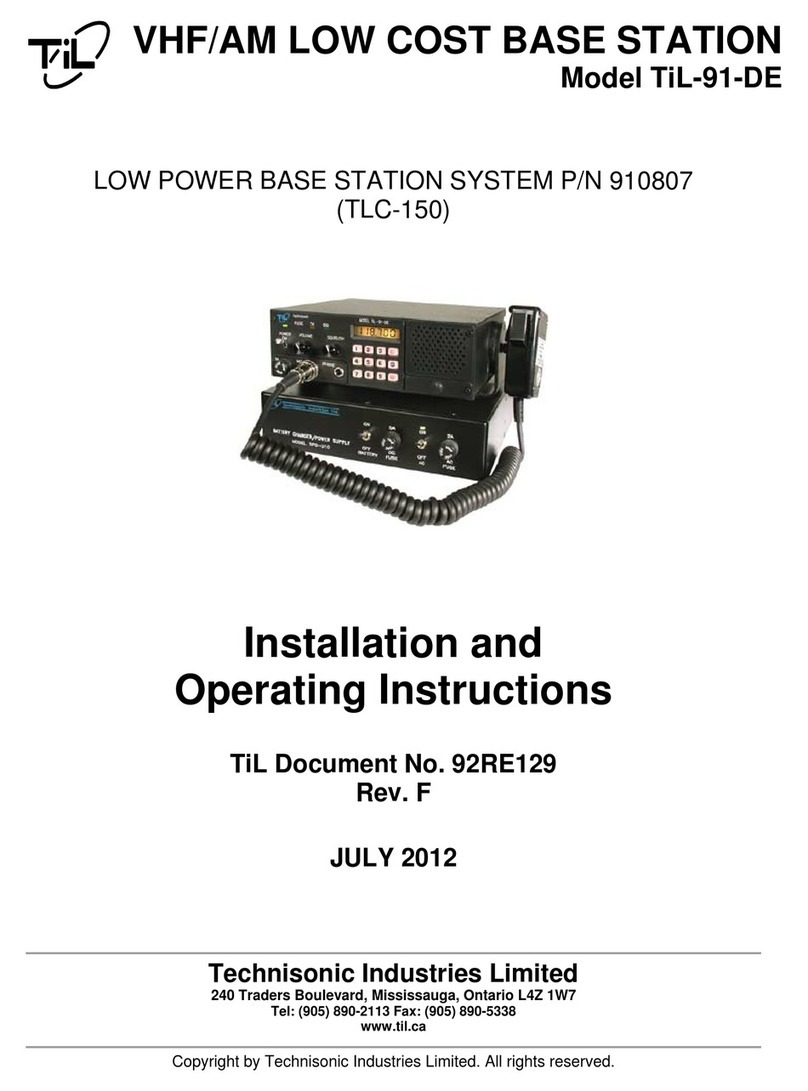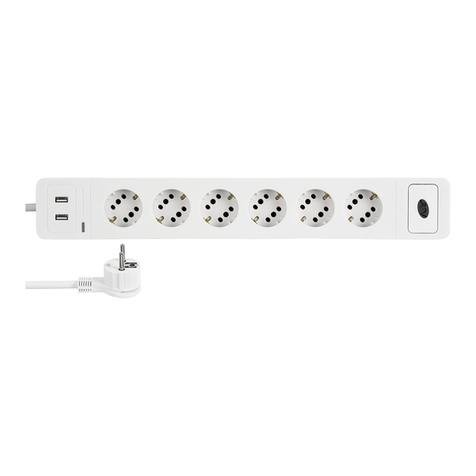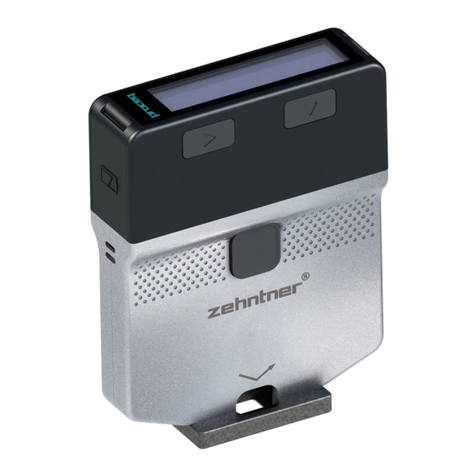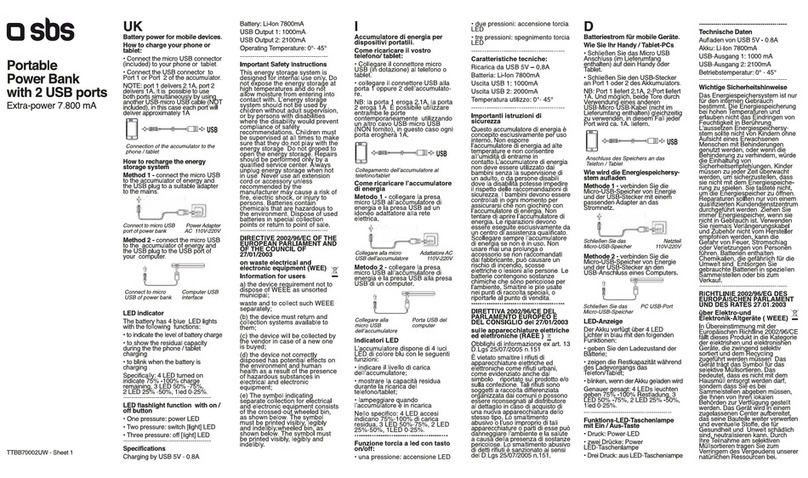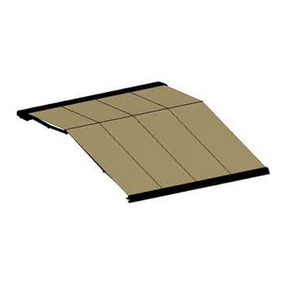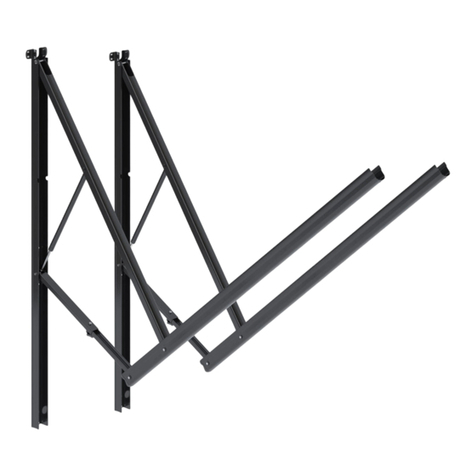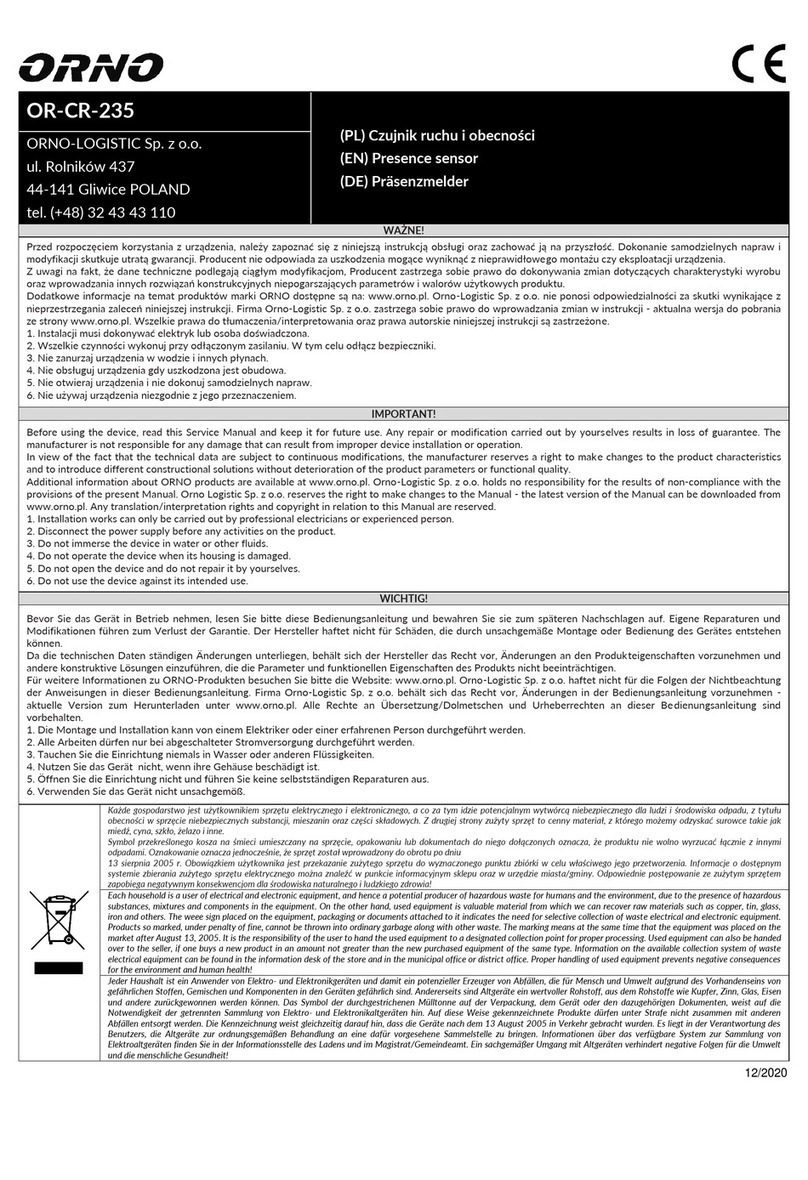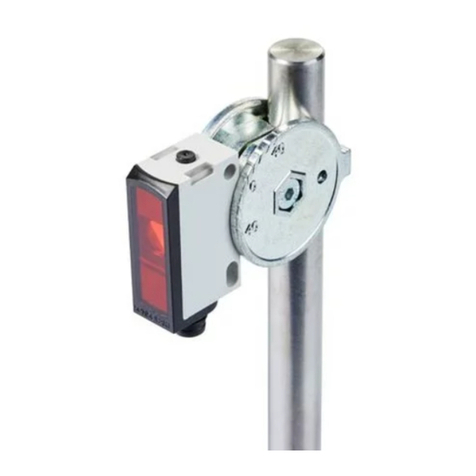Technisonic Industries Limited TiL-90-6R User manual

VHF/AM BASE STATIONS
MODEL TiL-90-6R
7 WATT SYSTEM NO. 920707 (TBS-100)
15 WATT SYSTEM NO. 910915 (TBS-200)
25 WATT SYSTEM NO. 910925 (TBS-300)
Installation and
Operating Instructions
Til Document No.
92RE123
Rev. E
Revised
October 2002
Technisonic Industries Limited
240 Traders Blvd., Mississauga, Ontario L4Z 1W7 Tel:(905)890-2113 Fax:(905)890-5338
www.til.ca

REVISIONS
REV PAGE DESCRIPTION DATE APPROVED
A
B
B
D
E
DOCUMENT
94RE149
PAGES 8-73
TO 8-76
DOCUMENT
92RE123
DOCUMENT
94RE149
Section 5
Section 6
Section 8
DOCUMENT
92RE123
Sections 1,2
and 3
Document
92RE123
P/L revised and pages replaced
accordingly
Fig.3-3 Layout picture updated
to reflect latest configuration
Schematics and layouts updated or
addded to reflect latest configuration
Fig. 6-2 replaced with 90-6R
Transceiver Exploded View
P/L format changed to new format
Fig. 8-2 updated
Fig. 8-1 updated
Sections 1, 2 and 3 updated to reflect
latest configuration available.
External frequency board and EIA
tone card.
Sections 1,2 and 3 updated to cover
new dual conversion information and
battery back-up kits.
5/0ct/9
5
6/Oct/
97
Oct/
1997
Oct/
2002 RR

WARNING
Do not make physical contact with antenna when transmitter is on. This unit can produce up to
30 watts of power (depending on configuration) when operated in high power mode.
CAUTION
This unit contains static sensitive devices. Wear a grounded wrist strap and/or conductive
gloves when handling printed circuit boards.
WARRANTY INFORMATION
The Base Stations, Model 91-DE series and Model Til 90-6R series are under warranty for one
year from date of purchase. Failed units caused by defective parts, or workmanship should
be returned to:
Technisonic Industries Limited
240 Traders Blvd.
Mississauga, Ontario L4Z 1W7 Amherst, NY
Tel: (905) 890-2113 Tel: (716) 691-0669
Fax: (905) 890-5338
A Page

i
TABLE OF CONTENTS
Paragraph Title Page
SECTION 1 GENERAL DESCRIPTION
1.1 Introduction ................................................ 1-1
1.2 Description ................................................. 1-1
1.2.1 Transceivers - Models Til-91-DE, Til-90-6R ........................ 1-3
1.2.2 Power Supply Modules - Models SPG-007, SPG-015, SPG-025 ......... 1-3
1.2.3 RF Amplifier Modules - Models PA-15, PA-25 ....................... 1-3
1.2.4 Distribution Board - P/N 923057-2 ............................... 1-3
1.2.5 RemoteControlBoards ....................................... 1-4
1.2.6 Microphone P/N 861902-1 ..................................... 1-4
1.2.7 Antenna ................................................... 1-4
1.3 Modes of Operation .......................................... 1-5
1.3.1 Transmit/Receive Modes (Local Mode) ........................... 1-5
1.3.2 Local/RemoteOperation....................................... 1-5
1.3.3 AC and DC Operation ......................................... 1-6
1.4 TechnicalSummary .......................................... 1-6
SECTION 2 PREPARATION FOR USE AND STORAGE
2.1 Introduction ................................................ 2-1
2.2 Disassembly/Assembly........................................ 2-1
2.2.1 Remove/ReplaceCoverAssembly ............................... 2-1
2.2.2 Remove/Replace Microphone ................................... 2-1
2.2.3 Remove/ReplaceTransceiver................................... 2-2
2.2.4 Remove/Replace Power Supply ................................. 2-4
2.2.5 Remove/Replace RF Power Amplifier Module ....................... 2-5
2.2.6 Remove/ReplaceDistributionBoard .............................. 2-5
2.2.7 Remove/ReplaceControlBoard ................................. 2-6
2.3 RemoteOperationSetUp-LineInterfaceBoards ................... 2-6
2.3.1 Two/Four Wire Line Interface board P/N 923051-1 (TLI-203) ........... 2-8
2.3.2 Two Wire Line Interface board P/N 943180-1 (TLI-205) ............... 2-8
2.4 Loudspeaker, Headphone Installation ............................ 2-11
2.4.1 External Loudspeaker ........................................ 2-11
2.4.2 Headset .................................................. 2-11
2.5 Operational Check .......................................... 2-11
2.6 Storage .................................................. 2-11

ii
TABLE OF CONTENTS (Continued)
Paragraph Title Page
SECTION 3 TRANSCEIVER SET UP and OPERATING INSTRUCTIONS
3.1 Introduction ................................................ 3-1
3.1.1 Transceiver Model TiL-90-6R P/N 861605-2 ........................ 3-1
3.1.2 TechnicalSummary .......................................... 3-1
3.2 Operators Switches, Controls and Indicators ....................... 3-1
3.3 Front Panel Operation ........................................ 3-7
3.3.1 OperationinTransmitMode .................................... 3-7
3.4 Channel Frequency Selection ................................... 3-8
3.4.1 Introduction ................................................ 3-8
3.4.2 Frequency Range ............................................ 3-8
3.4.3 Preparation ................................................. 3-8
3.4.4 Preprogramming Channel Frequencies ........................... 3-11
3.4.5 Completion of Programming Module A5 .......................... 3-13
3.4.6 Operational Checks ......................................... 3-13
3.5 General Operating Instructions ................................. 3-13
3.5.1 Preparation for Use ......................................... 3-13
3.5.2 TransmitterOperation........................................ 3-14
3.5.3 ReceiverOperation.......................................... 3-15
3.5.4 SwitchingOFF ............................................. 3-15
3.5.5 BatteryCharging............................................ 3-16
3.5.6 ExternalDCOperation ....................................... 3-16
LIST OF TABLES
Table No. Title Page
1-1 BaseStationConfigurations .................................... 1-1
1-2 Base Station Leading Particulars ................................ 1-7
2-1 9-Pin "D" Type Remote Connector Functions ....................... 2-7
2-2 9-Pin Positronics Type Remote Connector Functions ................. 2-8
3-1 Model Til-90-6R Transceiver Leading Particulars .................... 3-3
3-2 Operators Switches, Controls and Indicators ....................... 3-5
3-3 Frequency Selection MHz ...................................... 3-9
3-4 Frequency Selection KHz ..................................... 3-10

iii
LIST OF ILLUSTRATIONS
Figure No. Title Page
1-1 BaseStations................................................. 1-2
2-1 BaseStationAssembly/Disassembly ............................... 2-3
2-2 Line Interface/Control Board, P/N 923051-1 (TLI-203) .................. 2-9
2-4 Line Interface/Control Board, P/N 943180-1 (TLI-180) ................. 2-10
3-1 BaseStationSetUp ............................................ 3-2
3-2 Base Station Front and Rear Panel Layout ........................... 3-4
3-3 Frequency Set-Memory Module A5A1 - Component Layout ............. 3-12

1-1
SECTION 1
GENERAL DESCRIPTION
1.1 INTRODUCTION
Sections 1 and 2 of this publication provide general information on Technisonic VHF/AM
Base Station Systems, Item No.'s TBS-100/150,TBS-200/250 and TBS-300/350. Specific
information for the Base Station Models indicated on the front cover can be found in Section
3.
All Base Station Systems consist of a simplex transceiver complete with microphone,
operating over the frequency range of 117.975 MHz to 138.000 MHz. The Base Station
Systems are intended for operation in an aeronautical environment and can operate from
AC power or external DC power in local and remote operating modes.
1.2 DESCRIPTION
The six base station configurations utilize either the keypad entry transceiver (TiL 91-
DE) or six channel (TiL 90-6R) pre-programmable transceiver configured for 7 Watt, 15 Watt
or 25 Watt operation. All systems are now configured to accept the TLI-203 or TLI-180 Line
Interface/Control board for remote operation. Each base station consists of a Transceiver,
Power Supply Module, RF Amplifier Module, Microphone and Line Interface/Control Board
(optional). Refer to Table 1-1 for system configuration details.
TABLE 1-1 BASE STATION CONFIGURATIONS
System Transceiver Power Supply RF Amplifier Line/Remote
Control
Card
91-DE, 7W Base Station
Item No. TBS-150
Model 91-DE
P/N 901006
SPG-007
P/N 921020-1
Not Required Optional in all
Units
TLI-203
P/N
923051-1
TLI-180
P/N
943180-1
91-DE, 15W Base Station
Item No. TBS-250
Model 91-DE
P/N 901006
Option 1
SPG-015
P/N 911018-1
PA-15
P/N 912025-1
91-DE, 25W Base Station
Item No. TBS-350
Model 91-DE
P/N 901006
Option 1
SPG-025
P/N 911019-1
PA-25
P/N 922062-1
90-6R, 7W Base Station
Item No. TBS-100
Model 90-6R
P/N 861605
SPG-007
P/N 921020-1
Not Required
90-6R, 15W Base Station
Item No. TBS-200
Model 90-6R
P/N 861605
Option 1
SPG-015
P/N 911018-1
PA-15
P/N 912025-1
90-6R, 25W Base Station
Item No. TBS-300
Model 90-6R
P/N 861605
Option 1
SPG-025
P/N 911019-1
PA-25
P/N 922062-1

1-2
Figure 1-1 TBS-Series Base Stations

1-3
1.2 DESCRIPTION (continued)
To improve the rejection of interfering signals, dual conversion receiver technology has
been incorporated on the Transmitter/Receiver (Module A1) board used in Technisonic
VHF/AM base stations. The second IF is 455kHz using a ceramic filter, which is
immune to high energy ringing. The dual conversion module also has a second local
oscillator, second mixer and ceramic filter. The first local oscillator is the original VCO.
The dual conversion receiver board, P/N 003494-1 was implemented into TBS and TSC
series base stations starting in January 2001. An option label on the chassis will indicate
OPTION 94 if the dual conversion board is installed. It is possible to retro-fit the dual
conversion receiver/transmitter board into older TSC/TBS series base station employing the
single conversion board. Please contact Technisonic for availability of an exchange board.
Note: If a new A1 Module has been retrofitted the squelch circuit must be aligned for
the receiver squelch to operate correctly.
The dual conversion receiver’s squelch knob must be rotated significantly more
clockwise (4 o’clock position) to obtain the same squelch setting (3uV) as a single
conversion receiver’s squelch knob set to the 12 o’clock (straight up) position.
If the dual conversion receiver’s squelch knob is set to the 12 o’clock position, signals
with a level greater than 0.5uV will open the squelch. At most airports this will not be
an adequate level of squelch. Please be aware of this squelch knob adjustment
variance when setting and/or comparing squelch levels of dual conversion vs. single
conversion base stations.
1.2.1 Transceivers - Models TiL-91-DE and TiL-90-6R
The basic model of either transceiver is required for the 7 Watt Base Stations. Option
1 indicates that the basic transceiver has Module A6, DC to DC convertor (allows 24Vdc
input) installed to facilitate operation with the RF Amplifier Module. Refer to Section 3 for
specific details on the Transceiver unique to the systems indicated on the front cover of this
document.
1. Transceiver Model TiL-91-DE, P/N 901006-2
Transceiver Model Til-91-DE, Part Number 901006-2, is a microprocessor controlled,
7 watt VHF/AM transceiver operating over the entire band of 117.975 to 138.000 Mhz in 25
Khz steps. The transceiver will store ten user selected frequency channels in addition to the
resident emergency channel of 121.500 MHz. Frequency Selection, Storage, Recall,
Channel Scan, Search, and Toggle modes are all selected by the 12 key keypad. Current
operating frequency is displayed on a backlit liquid crystal display (LCD). Refer to above
paragraph for details on new dual conversion receiver/transmitter A1 module.
2. Transceiver Model TiL-90-6R, P/N 861605-2
Transceiver Model 90-6R, Part Number 861605-2, is a 7 watt VHF/AM transceiver
which operates in simplex on six pre-programmable, frequency synthesized channels, with
25kHz channel spacing in the frequency range 117.975 MHz to 138.000 MHz.

1-4
Refer to above paragraph for details on new dual conversion receiver/transmitter A1
module.
1.2.2 Power Supply Modules - Models SPG-007, SPG-015, SPG-025
The Power Supply Modules provide the DC supply voltage to the Transceiver and
Linear Amplifier, and house a battery charger which can provide charging and trickle
charging to external rechargeable batteries. Model SPG-007 (12Vdc input) is for use in the
7 Watt units, Model SPG-015 (24 Vdc input) is for use in the 15 Watt units, Model SPG-025
(24 Vdc input) is for use in the 25 Watt configurations.
1.2.3 RF Amplifier Modules - Models PA-15 and PA-25
The RF Amplifier Modules provide 15 Watt (Model PA-15) or 25 Watt (Model PA-25)
power output when the front panel switches are set to High. The RF Amplifiers are fed
by the 7 Watt RF output from the transceiver. An internal mounted RF relay bypasses the
RF Amplifier in receive and low power transmit modes.
1.2.4 Distribution Board - P/N 923057-2
The distribution board provides all interconnection between the external DC connector,
RF amplifier module, power supply/charger, remote control board (optional), and
transceiver. The optional TLI-203/180 remote control card is mounted on the distribution
board. The p/n 923057-1 distribution board is now standard and provides standard signal
outputs (see Table 2-1), when used in conjunction with the optional TLI-203 or TLI-180 Line
Interface/Remote Control boards.

1-5
1.2.5 Remote Control Boards
1. Line Interface Board P/N 923051-1 (TLI-203)
Provides remote control transceiver operation on 2 wire or 4 wire dedicated 600 ohm
lines. This board can be configured to key the transmitter using continuous tone (2175Hz
standard), plus/minus DC Voltages, ground keying and external current loop keying.
Transmit and Receive audio is user selectable for two wires or four wires. Crystals for tone
frequencies other than 2175 Hz may be obtained by special order. Adjustable (30-300
seconds) Tx time out function provided.
2. Line Interface Board P/N 943180-1 (TLI-180)
Provides remote control transceiver operation on 2 wire dedicated 600 ohm lines utilizing
the EIA multi-tone keying format found in the Land Mobile Industry. A high level 2175 tone
followed by a 1950 Hz guard tone and then a low level 2175 Hz continuous tone is utilized
to key the transceiver. The TLI-180 board can also be jumper strapped for standard
aeronautical 2175 Hz continuous tone operation.
NOTE
The TLI-203 or TLI-180 remote control boards are extra cost options in TBS-series,
Technisonic Base Stations. To determine if your Base station has a remote card installed
the “Configuration Label” located on the rear of the base station chassis s hould be
consulted. P/N 923051-1 is the default board supplied in all units when the optional card is
ordered. The EIA multi-tone board P/N 943180-1 must be special ordered.
1.2.6 Microphone P/N 861902-1
An illustration of the Microphone Assembly Part Number 861902-1, is included in Figure
1-1. The Assembly P/N 861902-1 consists on microphone P/N 861901-1 and microphone
retaining bracket P/N 863905-1. The unit is a rugged hand-held microphone housed in a
high impact plastic case. The dynamic microphone is a noise cancelling type with a
two-stage preamplifier, press-to-talk switch, and a retractable three-core cable terminated
by a three-pin, male contacts, connector which mates with the MIC/PTT connector located
on the front panel of the transceiver. The microphone dc supply for the microphone is
supplied by the transceiver. The microphone bracket can be mounted on the left or right
side of the Base Station as required.
1.2.7 Antenna
This unit is designed for use with a 50 ohm impedance antenna (not supplied). A 50
ohm RF "N" type connector (BNC available as an option) is provided on the rear of the unit
for interfacing with an antenna.

1-6
1.3 MODES OF OPERATION
Refer to Section 3 for additional operating modes.
1.3.1 Transmit/Receive (Local Mode)
The transceiver may be operated in either of two modes; transmit or receive, as selected
by the Press-to-Talk (PTT) switch on the microphone.
(1) TRANSMIT MODE - When the PTT switch on the microphone is pressed, the
transceiver operates in the transmit mode. The PTT signal line is grounded by the
microphone PTT switch via the microphone lead and the MIC/PTT connector to the
transceiver. The Tx ON amber LED will go ON, indicating that the transmitter is
activated.
Transmission will occur on the channel frequency indicated on the front panel. Refer
to Section 3 for transceiver details.
(2) RECEIVE MODE - When the PTT switch on the microphone is released, the
transceiver operates in the receive mode. The Tx ON amber LED will go OFF,
indicating that the transmitter is inhibited.
The setting of the SQUELCH CONTROL determines the squelch threshold level.
When the SQUELCH CONTROL is rotated in the counter-clockwise direction, the
SQUELCH INDICATOR green LED will go ON, indicating that the squelch circuit is
connecting the demodulated audio to the VOLUME CONTROL. The setting of the
VOLUME CONTROL determines the audio level produced from the internal speaker.
When the VOLUME CONTROL is adjusted in the clockwise direction, the audio level
will increase.
NOTE
When the connector of the external loudspeaker
or head phone is connected to the
SPEAKER/PHONE jack, the internal loudspeaker
is disconnected and the VOLUME CONTROL will
control the audio level of the external
loudspeaker or headphone.
1.3.2 Local/Remote Operation
All base stations which employ either the TiL-90-6R or TiL-91-DE transceiver can
operate in local and remote modes simultaneously. Some early TiL-91 DE base stations
were supplied with a switch with which either local or remote operation mode had to
be selected. Please note that if a TLI-203 or 180 remote control card is not installed
no remote signals will be available on the 9-pin D connector located on the rear of the
base station chassis.

1-7
1. LOCAL OPERATION - In local operation, voice audio, and keying (PTT) functions
are routed from the microphone to the transceiver. Receive audio is routed to the
internal loudspeaker.
2. REMOTE OPERATION - In Remote operation, transmit audio, keying (PTT), and
receive audio functions are routed over land lines to the 600 ohm remote input.
Internal jumpers can be set for ±DC, ground transmitter keying, tone keying or
current loop keying, depending on the line interface/remote control board utilized.
1.3.3 AC and DC Operation
The unit can be operated by external 120 VAC (220 VAC operation possible) or external 28
VDC (13.7 VDC for 7W configurations). 220 VAC operation can be selected by moving a
jumper on the AC power supply, module A8.
1. AC OPERATION - During AC operation, the unit can charge and trickle charge
external batteries via the External DC connector mounted on the rear panel of the
Base Station. Refer Table 1-2 for details.
2. DC OPERATION - The unit can be operated from an external DC supply within
the range of 21.6 Vdc to 30 Vdc for 15 watt and 25 watt configurations and within
the range of 11.5 Vdc to 15.0 Vdc for 7 watt configurations. A DC connector is
mounted on the rear of the Base Station which mates with DC Power Cable P/N
863701-1 (not supplied) to facilitate external DC operation.
The following battery back-up kits are available for TBS-series base stations:
P/N 989978-1, 24 Volt Battery Back-up Kit (7.2 AH)
For use with 15watt/25watt TBS-series Base Stations. Provides a minimum of 4 hours
back-up for 25 watt unit with 20% Tx and 80% Rx duty cycle. Note: Back-up time for
15 watt unit is approximately 40% longer.
Kit includes:
qty. (1) p/n 987370-3, DC mating cable with battery connectors.
qty. (2) p/n LCR 12V7.2P, 7.2 amp hour sealed lead acid batteries.
qty. (1) p/n 987246-2, battery interconnect cable.
qty. (1) p/n 968211, battery hook-up instructions.
P/N 989979-1, 12 Volt Battery Back-up Kit (7.2 AH)
For use with 7 watt TBS-series Base Stations. Provides a minimum of 6.5 hours back-
up for 7 watt unit with 20% Tx and 80% Rx duty cycle.
Kit includes:
qty. (1) p/n 987370-3, DC mating cable with battery connectors.
qty. (1) p/n LCR 12V7.2P, 7.2 amp hour sealed lead acid battery.
qty. (1) packing log/ instructions.
1.4 TECHNICAL SUMMARY
A summary of electrical, operational, mechanical and physical characteristics of the
Base Station are provided in Tables 1-2 and 3-1.

1-8
TABLE 1-2 BASE STATION SYSTEM LEADING PARTICULARS
POWER REQUIREMENTS:
7 Watt Base Stations
AC Input Voltage/Current ........................... 100 to 132 VAC @ 1.0 Amp
AC Input Voltage/Current (Available) ................. 190 to 250 VAC @ 0.5 Amp
DC Input Voltage/Current ...................... 11.5VDCto15VDC@3.5Amp
15 Watt Base Stations
AC Input Voltage/Current ........................... 100 to 132 VAC @ 1.5 Amp
AC Input Voltage/Current (Available) ................. 190 to 250 VAC @ 0.8 Amp
DC Input Voltage/Current ...................... 21.6VDCto30VDC@4.0Amp
25 Watt Base Stations
AC Input Voltage/Current ........................... 100 to 132 VAC @ 2.0 Amp
AC Input Voltage/Current (Available) ................. 190 to 250 VAC @ 1.0 Amp
DC Input Voltage/Current ...................... 21.6VDCto30VDC@7.5Amp
POWER OUTPUT:
7WattBaseStations .................................................. 5-10Watts
15WattBaseStations(Low/High) ................................... 5-10/10-20Watts
25WattBaseStations(Low/High) ................................... 5-10/20-30Watts
Microphone Compression Range .....................................................35dB
Battery Charger Voltage & Current (15 & 25 watt configurations) ........... 27.5Vdc,3.5AmpsMAX
OPTIONAL REMOTE CONTROL BOARD - TLI-203
Remote Audio Input ............................... 2or4wire(selectable),balanced600 Ωlines
Remote Tx Timeout ..................................................... 30to300 seconds
Tone Keying:
Impedance ............................................. 600 Ωfloating with respect to ground
TxControlTone........................................................ 2175 Hz, standard
Tx Tone Input Level .......................................................... 0to-40dBm
Tx Tone Control Response Time ............................................<12milliseconds
DCKeying .....................................................................±48Vdc
Loop Resistance ............................................................. 10KΩMAX
Ground Keying ......................................................... ClosuretoGround
Loop Resistance .............................................................. 4KΩMAX
Remote RX:
Range ......................................... +10dBmto-15dBm(Factorysetto-10dBm)
Impedance ............................................. 600 Ωfloating with respect to ground
RX/TX Interface Signals:
Squelch Signal ................................................ Ground, Open circuit for Mute
TX RF Output Signal (Optional) ...........................RFON=Ground,RF OFF=Open Circuit
AGC Signal Output ..................................................... Linear 0 to +6 Vdc
Temperature & Humidity:
Operating Temperature Range .......................... -25EC(-13EF) to +55EC(+131EF)
Storage Temperature Range ........................... -55EC(-67EF) to +65EC(+149EF)
RelativeHumidity ........................................................... 100%
Dimensions & Weight:
Width ...................................................... 305 mm (12.0 in) MAX
Height(includingfeet) .......................................... 166 mm (6.5 in) MAX
Depth ..................................................... 274 mm (10.75 in) MAX
Weight ....................................................... 5.5Kg(12lbs)MAX
* Refer to Section 3 for Model 90-6R or 91-DE transceiver specifications

2-1
SECTION 2
PREPARATION FOR USE AND STORAGE
2.1 INTRODUCTION
This section provides the information required for custom configuration of the base
station, and storage. Custom system configuration includes customizing remote control set
up, and removal and replacement of Power Amplifier Module, Transceiver, and Power
Supply.
Refer to Section 3 for Channel/Frequency configuration.
CAUTION: Antenna must be connected to transceiver before transmitting or permanent
damage to the output stage may occur.
2.2 DISASSEMBLY/ASSEMBLY (Refer to Figure 2-1)
2.2.1 Remove Replace Microphone
REMOVAL
(1) Disconnect microphone (item 7) from front panel of transceiver (item 8). Slide
microphone clear of bracket (item 6).
(2) Remove and Retain two screws (item 5) securing microphone bracket (item 6)
to cover (item 2).
REPLACEMENT
(1) Secure microphone bracket (item 6) to left or right side of cover (item 3) as
required with two screws and two washers (item 5).
(2) Connect microphone (item 7) to front panel connector on transceiver (item 8).
Slide microphone onto bracket (item 6).
2.2.2 Remove/Replace Cover Assembly
NOTE
It is necessary to first remove Microphone
Bracket before removing Cover.
Remove screws securing Heat Sink to cover last,
after removing all other top and bottom screws.

2-2
2.2.2 Remove/Replace Cover Assembly - continued
REMOVAL
(1) Remove and retain two top screws (item 1) securing cover (item 3) to chassis
(item 4).
(2) Remove and retain four bottom screws (item 2) securing cover to chassis.
(3) Remove and retain the two heatsink screws.
(4) Slide cover forward or backward to lift cover clear of chassis.
REPLACEMENT
(1) Slide cover (item 3) forward or backward onto chassis (item 4), positioning
screw access holes on cover over chassis threaded inserts.
(2) Secure heatsink to cover with two screws.
(3) Secure cover to chassis with four bottom screws (item 2), then with two top
screws (item 1).
2.2.3 Remove Replace Transceiver
REMOVAL
(1) Remove Cover as described in paragraph 2.2.2.
(2) Disconnect coaxial connector (item 9) from rear of transceiver (item 8).
(3) Disconnect DC connector (item 10) from rear of transceiver.
(4) Remove and retain two screws and two washers (item 11) securing flat cable
(item 12) to transceiver. Disconnect flat cable from transceiver.
(5) Remove and Retain two screws and two washers (item 13) securing transceiver
to chassis bracket.
(6) Slide transceiver toward rear of chassis. Lift transceiver clear of chassis.

2-3
Figure 2-1 Base Station Assembly/Disassembly

2-4
2.2.3 Remove Replace Transceiver - continued
REPLACEMENT
(1) Slide transceiver from rear of chassis into top window of front panel.
(2) Secure transceiver to chassis bracket with two screws and two washers.
(3) Connect flat cable (item 12) to transceiver. Secure flat cable to transceiver with two
screws and two washers (item 11).
(4) Connect DC connector (item 10) to rear of transceiver.
(5) Connect coaxial connector (item 9) to rear of transceiver.
(6) Replace Cover as described in paragraph 2.2.2.
2.2.4 Remove Replace Power Supply
REMOVAL
(1) Remove Cover as described in paragraph 2.2.2.
(2) Loosen two screws and two washers (item 14) securing Power Supply (item
15) to chassis (item 3).
(3) Remove and Retain one screw (item 16) securing Power Supply to bottom of
chassis.
(4) Slide Power Supply forward through window using partially loosened screws
(item 14). Remove and retain two screws and two washers.
REPLACEMENT
(1) Slide Power Supply (item 15) part way into lower front panel window until
screw inserts are visible through chassis bracket holes.
(2) Partially install screws and washers (item 14).
(3) Grasp two screws (item 14) with fingers to position Power Supply into chassis
mounted connectors. Press into position from front panel.
(4) Secure Power Supply to chassis with one screw (item 16) on bottom of chassis.
(5) Tighten screws (item 14)
(6) Replace Cover as described in paragraph 2.2.2.

2-5
2.2.5 Remove Replace RF Power Amplifier Module
REMOVAL
CAUTION
Do not adjust nut or shaft (item 19) protruding
from RF Power Amplifier Module. This is a Power
Transistor Mounting Stud.
(1) Remove Cover as described in paragraph 2.2.2.
(2) Disconnect coaxial connector (item 9) from Transceiver (item 8).
(3) Disconnect Flat Cable from Distribution Board (item 23).
(4) Remove and retain two bottom screws (item 17) and one rear screw (item 18)
securing RF (15W) Power Amplifier (item 20) to chassis (item 4). Note: 25W RF
Power Amplifier has four bottom screws (item 17) securing it to the chassis.
REPLACEMENT
(1) Secure RF Power Amplifier (item 20) to chassis with bottom screws (item 17)
and one rear screw (item 18).
(2) Connect UHF Connector (item 9) to Transceiver and flat cable to distribution
board.
(3) Replace Cover as described in paragraph 2.2.2.
2.2.6 Remove Replace Distribution Board
REMOVAL
(1) Remove Cover as described in paragraph 2.2.2. Disconnect flat ribbon cables.
(2) Remove and retain four screws (item 25) securing the distribution and control
boards (item 23,24) to the rear of chassis (item 4).
REPLACEMENT
(1) Secure Distribution Board and Control Board (item 23) to the rear of chassis
(item 4) with four screws (item 25).
(2) Reconnect flat ribbon cables and replace Cover as described in paragraph 2.2.2.

2-6
2.2.7 Remove Replace Control Board
REMOVAL
(1) Remove Cover as described in paragraph 2.2.2.
(2) Remove Distribution Board as described in paragraph 2.2.6.
CAUTION
Care must be taken when removing or replacing
Control Board to avoid damage to Distribution
Board Pins.
(3) Remove and retain four screws (item 21) securing Control Board (item 22)
"piggy back" to the Distribution Board (item 23). Remove Control Board from
Distribution Board.
REPLACEMENT
(1) Align the two female connectors on the control board with the male connectors
on the Distribution Board using the four mounting holes and standoffs as a guide.
(2) Secure control board "piggy back" to the distribution board (item 23) with four
screws (item 21).
(3) Replace Distribution Board as described in paragraph 2.2.6 and replace Cover
as described in paragraph 2.2.2.
2.3 REMOTE OPERATION SET UP - Line Interface Boards
The Procedures listed below enable the user to custom configure the unit for external
remote control hardware. Refer to Table 2-1 for connector pin details on Remote Control
D Connector located at rear of Base Station or Table 2-2 for connector pin out on the
special order Positronics 9-pin connector. Position jumpers on Line Interface Board as
indicated Figures 2-2 or 2-3 as required. Verify Remote Control operation in accordance
with manufacturer’s instructions.
TWO WIRE SETUP - In two wire operation, a single balanced 600 ohm pair is provided
for transmit and receive audio. The transmitter can be keyed on the same pair or externally.
FOUR WIRE SETUP - In four wire operation, separate balanced 600 ohm pairs are
provided for transmit and receive audio. The transmitter can be keyed on the Tx audio pair
or externally.
DC KEYING - In ± DC keying, a positive voltage between +10 Vdc and +48 Vdc or
negative voltage between -10 Vdc and -48 Vdc will key the transmitter. A DC voltage
between -5 Vdc and +5 Vdc will not key the transmitter.
Other manuals for TiL-90-6R
1
Table of contents
Other Technisonic Industries Limited Accessories manuals
